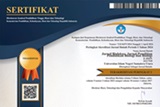BIODIVERSITAS MAKROFUNGI DI SEKITAR KAWASAN CURUG LEUWI MANGROD, KABUPATEN SERANG, BANTEN: DESKRIPSI DAN POTENSI PEMANFAATAN
Abstract
Fungi are found widely in tropical areas throughout the world, including Indonesia. Banten Province is estimated to have a high diversity of macrofungi. This study aims to explore and describe the morphological characteristics of macrofungi and their potential use in the area of Curug Leuwi Mangrod Cibojong, Padarincang, Serang Regency, Banten. The research was conducted in September - October 2021 using the cruising method. A total of 10 species of macrofungi consisting of 1 species of the Ascomycota division and 9 species of the Basidiomycota division were found around the waterfall from various substrates, both on the soil surface and on rotten tree trunks. A total of 3 species were found to be potential sources of food, 9 species had the potential to be used as medicinal ingredients. Information on the diversity and potential use of macrofungi can be used as a basis for further macrofungi development.
Keywords
Full Text:
PDFReferences
Al-Ulya, A. N., Leksono, S. M., & Khastini, R. O. (2017). Biodiversitas Dan Potensi Jamur Basidomycota Di Kawasan Kasepuhan Cisungsang, Kabupaten Lebak, Banten. Al-Kauniyah: Jurnal Biologi, 10(1), 9–16. https://doi.org/10.15408/kauniyah.v10i1.4513.
Antonin, V. (2017). Allopsalliota, a New Genus For Agaricus Geesterani Author (s): Marijke M . Belgian Journal of Botany. 131(1998), 181–190.
Basso, V., Schiavenin, C., Mendonça, S., de Siqueira, F. G., Salvador, M., & Camassola, M. (2020). Chemical features and antioxidant profile by Schizophyllumcommune produced on different agroindustrial wastes and byproducts of biodiesel production. Food Chemistry, 329(127089), 1-7. https://doi.org/10.1016/j.foodchem.2020.127089.
Cadelis, M. M., Copp, B. R., & Wiles, S. (2020). A review of fungal protoilludane sesquiterpenoid natural products. Antibiotics, 9(12), 1–29. https://doi.org/10.3390/antibiotics9120928.
Cör, D., Knez, Ž., & Hrnčič, M. K. (2018). Antitumour, antimicrobial, antioxidant and antiacetylcholinesterase effect of Ganoderma lucidum terpenoids and polysaccharides: A review. Molecules, 23(3), 1–21. https://doi.org/10.3390/molecules23030649.
Darkal, A. K., Zuraik, M. M., Ney, Y., Nasim, M. J., & Jacob, C. (2021). Unleashing the biological potential of fomes fomentarius via dry and wet milling. Antioxidants, 10(2), 1–21. https://doi.org/10.3390/antiox10020303
Elfirta, R. R., & Saskiawan, I. (2020). The Functional Character of Auricularia auricula Crude Polysaccharides: Antioxidant and Antibacterial Activity. Berita Biologi, 19(3), 433–440. https://doi.org/10.14203/beritabiologi.v19i3 B.3988.
Global Biodiversity Information Facility. (2021). Taxonomic Distribution of Occurences. https://www.gbif.org/occurrence/taxonomy?country=ID&taxon_key=5.
Gebreyohannes, G., Nyerere, A., Bii, C., & Sbhatu, D. B. (2019). Investigation of Antioxidant and Antimicrobial Activities of Different Extracts of Auricularia and Termitomyces Species of Mushrooms. Scientific World Journal, 2019(3), 1-10. https://doi.org/10.1155/2019/7357048.
Harahap, L., Syamsi, F., & Efendi, Y. (2017). Inventarisasi Jamur Tingkat Tinggi (Basidiomycetes) Di Taman Wisata Alam Muka Kuning Batam. Simbosa. 6(2),74–84.
Hasanuddin. (2018). Jenis Jamur Kayu Makrokopis sebagai Media Pembelajaran Biologi. Jurnal Biotik, 2(1), 38-52.
Islam, M. R., Tudryn, G., Bucinell, R., Schadler, L., & Picu, R. C. (2017). Morphology and mechanics of fungal mycelium. Scientific Reports, 7(1), 1–12. https://doi.org/10.1038/s41598-017-13295-2.
Izati, et al. (2020). Keanekaragaman jamur makroskopis dan potensi pemanfaatannya di Cagar Alam Gunung Picis dan Cagar Alam Gunung Sigogor, Jawa Timur. Pros Semnas Masy Biodiv Indonesia, 6(1), 459-467.
Kalisz, A., & Siwulski, M. (2015). Auricularia spp. Mushrooms as Novel Food and Therapeutic Agents a Review. Sydowia, 67(15), 1–10. https://doi.org/10.12905/0380.sydowia67-2015-0001.
Karun, N. C., & Sridhar, K. R. (2016). Spatial and Temporal Diversity of Macrofungi in The Western Ghar Forest of India. Applied Ecology and Evironmental Research, 14(2), 1–2.
Kayode, R., Laba, S., Kayode, B., Aliyu, T., KO, S., & Opaleke, D. (2016). Chemical composition of Marasmius oreades; A wild edible mushroom among Kabba-Bunu inhabitants of Nigeria. FUTA Journal of Research in Sciences, 1(1), 1–8.
Khastini, R. O., Wahyuni, I., Lista, L., & Saraswati, I. (2019). Inventory and Utilization of Macrofungi Species for Food in Cikartawana Inner Baduy Banten. Biodidaktika, Jurnal Biologi Dan Pembelajarannya, 14(1), 7–13.
https://doi.org/10.30870/biodidaktika.v14i1.4838.
Lingga, R., Dalimunthe, N., Afriansyah, B., Riko, I., Henri, Januardi, E., Marinah, & Safitri. (2021). Keanekaragaman jamur makroskopik di hutan wisata desa tiang tarah kabupaten bangka. BIOMA : Jurna Ilmiah Biologi, 10(2), 181–200.
Mumpuni, A., Purnomowati, & Risyanto, S. (2012). Eksplorasi Jamur Kuping (Auricularia spp.) Indigenous Kabupaten Banyumas. Prosiding Seminar Nasional “Pengembangan Sumber Daya Pedesaan Dan Kearifan Lokal Berkelanjutan II,” 18–22.
Ng, K. P., Chan, C. L., Yew, S. M., Yeo, S. K., Toh, Y. F., Looi, H. K., Na, S. L., Lee, K. W., Yee, W. Y., & Kuan, C. S. (2016). Identification and characterization of Daldinia eschscholtzii isolated from skin scrapings, nails, and blood. PeerJ, 5, 1-19. https://doi.org/10.7717/peerj.2637.
Niego, A. G., Rapior, S., Thongklang, N., Raspé, O., Jaidee, W., Lumyong, S., & Hyde, K. D. (2021). Macrofungi as a nutraceutical source: promising bioactive compounds and market value. Journal of Fungi, 7(5), 1-32. https://doi.org/10.3390/jof7050397.
Noverita, N., Armanda, D. P., Matondang, I., Setia, T. M., & Wati, R. (2019). Keanekaragaman Dan Potensi Jamur Makro Di Kawasan Suaka Margasatwa Bukit Rimbang Bukit Baling (Smbrbb) Propinsi Riau, Sumatera. Pro-Life, 6(1), 26-43. https://doi.org/10.33541/pro-life.v6i1.935.
Nurilla, N., Setyobudi, L., & Nihayati, E. (2013). The study growth and production of wood ear mushroom (Auricularia auricula) on sawdust and cocopeat substrat. Jurnal Produksi Tanaman, 1(3), 40–47.
Nurlita, A. I., Putra, I. P., & Ikhsan, M. (2021). Catatan Pemanfaatan Schizophyllum commune di Kampung Udapi Hilir, Papua Barat. Integrated Lab Journal, 9(1), 18–28.
Putra, I. P. (2020). Note on Macro Fungi on Belitong Island: Description and Potential. Bioeduscience : Jurnal Pendidikan Biologi dan Sains, 4(1), 11–20. https://doi.org/10.29405/j.bes/4111-204416.
Prasetyaningsih, A & Rahardjo, D. (2015). Keanekaragaman dan Potensi Makrofungi Taman Nasional Gunung Merapi. The 2nd University Research Coloquium. ISSN 2407-9189.
Qi, L. F. R., Liu, S., Liu, Y. C., Li, P., & Xu, X. (2021). Ganoderic acid a promotes amyloid‐β clearance (In vitro) and ameliorates cognitive deficiency in alzheimer’s disease (mouse model) through autophagy induced by activating axl. International Journal of Molecular Sciences, 22(11), 1-18. https://doi.org/10.3390/ijms22115559.
Rahma, K., Mahdi, N & Hidayat, M. (2018). Karakteristik Jamur Mikroskopis di Perkebunan Kelapa Sawit Kecamatan Meureubo Aceh Barat. Prosiding Seminar Nasional Biotik, 6(1), 157-164.
Sari, P., Nazip, K., & Dayat, E. (2016). Jenis-Jenis Basidiomycota Di Kawasan Air Terjun Curug Pandan Kabupaten Lahat Serta Sumbangannya Pada Pembelajaran Biologi Di Sma (Basidiomycota Types in the Waterfall Curug Pandan Lahat and Contribution To High School Biology Learning). Jurnal Pembelajaran Biologi: Kajian Biologi Dan Pembelajarannya, 3(1), 66–74.
Singh, Y., & Kaur, M. (2016). Four newly recorded Amanita taxa from India. Biodiversitas : Journal of Biological Diversity, 17(1), 342–348. https://doi.org/10.13057/biodiv/d170146.
Subbulaksmi, M., & Kannan, M. (2016). Cultivation and phytochemical analysis of wild mushrooms Daldinia concentrica and phaeolus schweinitzii from Tamilnadu, India. Journal of Experimental Biology, 6, 46–54.
Sulastri, M. P & Basri, H. (2019). Identifikasi Makrofungi Di Taman Wisata Alam Gunung Tunak Kabupaten Lombok Tengah. Avesina, 13(1), 36-42.
Thiers, B. M., & Halling, R. E. (2018). The Macrofungi Collection Consortium. Applications in Plant Sciences, 6(2), 1–7. https://doi.org/10.1002/aps3.1021.
Wahyudi, T. R., Rahayu, S., & Azwin. (2016). Keanekaragaman Jamur Basidiomycota di Hutan Tropis Dataran Rendah Sumatera, Indonesia (Studi Kasus di Arboretum Fakultas Kehutanan Universitas Lancang Kuning Pekanbaru). Wahana Forestra: Jurnal Kehutanan, 11(2), 21–33. https://doi.org/10.31849/forestra.v11i2.148.
Widyastuti, N. (2019). Pengolahan Jamur Tiram (Pleurotus ostreatus) Sebagai Alternatif Pemenuhan Nutrisi. Jurnal Sains Dan Teknologi Indonesia, 15(3), 1-7. https://doi.org/10.29122/jsti.v15i3.3391.
Zeb, M., & Lee, C. H. (2021). Medicinal properties and bioactive compounds from wild mushrooms native to North America. Molecules, 26(2), 1-24. https://doi.org/10.3390/molecules26020251.
DOI: http://dx.doi.org/10.30821/biolokus.v5i1.1293
Refbacks
- There are currently no refbacks.
Copyright (c) 2022 Jurnal Biolokus: Jurnal Penelitian Pendidikan Biologi dan Biologi
indexed by :












